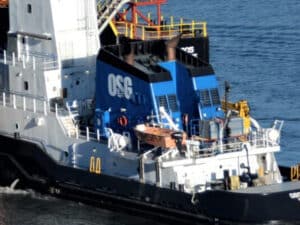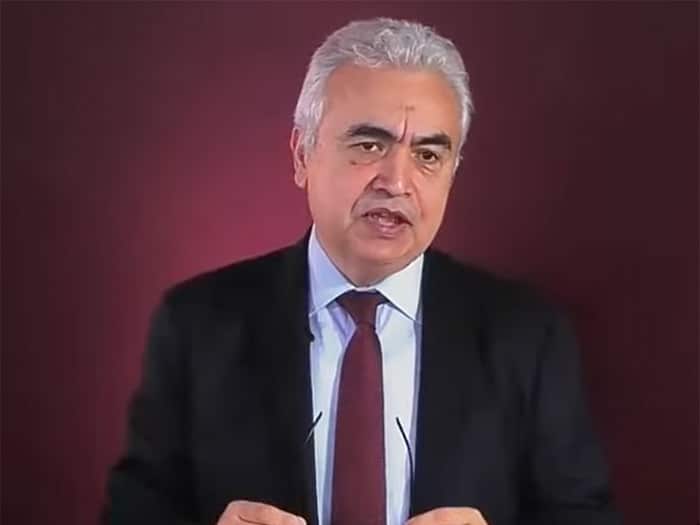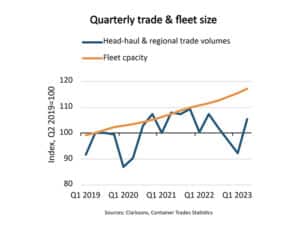
World Energy Outlook paints scenarios with major implications for shipping
Written by Nick Blenkey
IEA Executive Director Fatih Biro: “Energy markets and policies have changed as a result of Russia’s invasion of Ukraine, not just for the time being, but for decades to come.”
The global energy crisis triggered by Russia’s invasion of Ukraine is causing profound and long-lasting changes that have the potential to hasten the transition to a more sustainable and secure energy system, according to the latest edition of the International Energy Agency (IEA) World Energy Outlook.
At 525 pages, the World Energy Outlook is not a quick read. But it includes data with major implications for all sectors of shipping, and energy shipping in particular. For the first time, global demand for each of the fossil fuels shows a peak or plateau across all scenarios, with Russian exports in particular falling significantly as the world energy order is reshaped, says IEA.
AMMONIA TO BE LEADING MARINE FUEL BY 2050
Ships don’t only transport energy, they burn it. Here’s some of what the World Energy Outlook says about that:
“Maritime shipping is heavily reliant on oil, which meets virtually all its energy demand today. In the one World Energy Outlook scenario, the fuel mix for the shipping sector undergoes a major transformation, and its global CO2 emissions fall from 840 Mt CO2 today to 110 Mt CO2 by 2050. A number of fuels contribute to this decarbonization progress. By 2050, ammonia meets around 45% of demand for shipping fuel. Bioenergy and hydrogen each meet a further 20% of demand, with the use of hydrogen in particular focussed on short‐ to mid‐range operations. Electricity plays a minor role focussed on meeting demand from small ships and cruise ferries used for short‐ distance operations.
“Ships have a lifetime of 20‐35 years, which inhibits the uptake of new low‐emissions technologies and contributes to oil still constituting almost 15% of shipping fuel demand by 2050. Although it is possible to retrofit ships to run on low‐emissions hydrogen‐based fuels, this is complicated by the need for major investments and co‐ordinated efforts among fuel suppliers, ports, shipbuilders and shippers, especially when it comes to large transoceanic vessels. Efficiency measures such as wind kites and rotor sails also have an important role to play, since they help to reduce the need for fuel of any kind.”
GLOBAL ENERGY CRISIS
Today’s energy crisis is delivering a shock of unprecedented breadth and complexity. The biggest tremors have been felt in the markets for natural gas, coal and electricity – with significant turmoil in oil markets as well, necessitating two oil stock releases of unparalleled scale by IEA member countries to avoid even more severe disruptions. With unrelenting geopolitical and economic concerns, energy markets remain extremely vulnerable, and the crisis is a reminder of the fragility and unsustainability of the current global energy system, the World Energy Outlook 2022 (WEO) warns.
The WEO’s analysis finds little evidence to support claims that climate policies and net zero commitments have contributed to the run-up in energy prices. In the most affected regions, higher shares of renewables were correlated with lower electricity prices.
Alongside short-term measures to try to shield consumers from the impacts of the crisis, many governments are now taking longer-term steps. Some are seeking to increase or diversify oil and gas supplies, and many are looking to accelerate structural changes. The most notable responses include the U.S. Inflation Reduction Act, the EU’s Fit for 55 package and REPowerEU, Japan’s Green Transformation (GX) program, Korea’s aim to increase the share of nuclear and renewables in its energy mix, and ambitious clean energy targets in China and India.
In the WEO’s Stated Policies Scenario, which is based on the latest policy settings worldwide, these new measures help propel global clean energy investment to more than $2 trillion a year by 2030, a rise of more than 50% from today. As markets rebalance in this scenario, the upside for coal from today’s crisis is temporary as renewables, supported by nuclear power, see sustained gains. As a result, a high point for global emissions is predicted to be reached in 2025. At the same time, international energy markets undergo a profound reorientation in the 2020s as countries adjust to the rupture of Russia-Europe flows.
“Energy markets and policies have changed as a result of Russia’s invasion of Ukraine, not just for the time being, but for decades to come,” said IEA Executive Director Fatih Birol. “Even with today’s policy settings, the energy world is shifting dramatically before our eyes. Government responses around the world promise to make this a historic and definitive turning point towards a cleaner, more affordable and more secure energy system.”
For the first time ever, a WEO scenario based on today’s prevailing policy settings has global demand for every fossil fuel exhibiting a peak or plateau. In this scenario, coal use falls back within the next few years, natural gas demand reaches a plateau by the end of the decade, and rising sales of electric vehicles (EVs) mean that oil demand levels off in the mid-2030s before ebbing slightly to mid-century. This means that total demand for fossil fuels declines steadily from the mid-2020s to 2050 by an annual average roughly equivalent to the lifetime output of a large oil field.
Russia has been by far the world’s largest exporter of fossil fuels, but its invasion of Ukraine is prompting a wholesale reorientation of global energy trade, leaving it with a much-diminished position. All Russia’s trade ties with Europe based on fossil fuels had ultimately been undercut in previous WEO scenarios by Europe’s net zero ambitions, but Russia’s ability to deliver at relatively low cost meant that it lost ground only gradually. Now the rupture has come with a speed that few imagined possible. Russian fossil fuel exports never return – in any of the scenarios in this year’s WEO – to the levels seen in 2021, with Russia’s reorientation to Asian markets particularly challenging in the case of natural gas. Russia’s share of internationally traded energy, which stood at close to 20% in 2021, falls to 13% in 2030 in one WEO Scenario, while the shares of both the United States and the Middle East rise.
For gas consumers, the upcoming Northern Hemisphere winter promises to be a perilous moment and a testing time for EU solidarity – and the winter of 2023-24 could be even tougher. But in the longer term, one of the effects of Russia’s recent actions is that the era of rapid growth in gas demand draws to a close. In the Stated Policies Scenario, the scenario that sees the highest gas use, global demand rises by less than 5% between 2021 and 2030 and then remains flat through to 2050. Momentum behind gas in developing economies has slowed, notably in South and Southeast Asia, putting a dent in the credentials of gas as a transition fuel.
“Amid the major changes taking place, a new energy security paradigm is needed to ensure reliability and affordability while reducing emissions,” Dr. Birol said. “That is why this year’s WEO provides 10 principles that can help guide policymakers through the period when declining fossil fuel and expanding clean energy systems co-exist, since both systems are required to function well during energy transitions in order to deliver the energy services needed by consumers. And as the world moves on from today’s energy crisis, it needs to avoid new vulnerabilities arising from high and volatile critical mineral prices or highly concentrated clean energy supply chains.”




